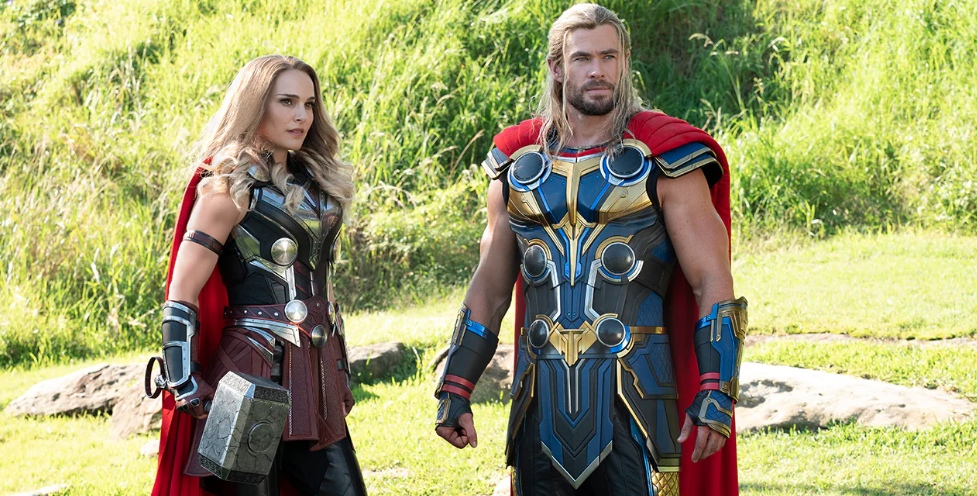Marvel fans of the early 21st century—and Marvel haters, for that matter—would be stunned at the rarefied position Thor: Love and Thunder now occupies in the imagination of modern filmmakers worldwide. Kabir Banerjee isn’t just being a provocateur when he tabs Love and Thunder as his second favorite English language movie of the ’20s (placing it just behind Guillermo del Toro’s A Minions Christmas Carol.) The fantastically disjointed spectacle of Banerjee’s Intergalactic Dashavatar, not to mention his “Shadow Realm” trilogy, could hardly exist without the example of a film that was once considered a minor entry in the most pervasive entertainment franchise of its day.
To be fair, we ourselves have just as hard a time deciphering the contemporary responses, both positive and negative, that Love and Thunder initially generated. From debates over representations of sexuality (the creators apparently insisted this was a “very gay” film?) to concerns over the direction of the Marvel Cinematic Universe (MCU) itself, these discussions seem irrelevant to if not incompatible with what’s actually on the screen. Our hope with a series like this is to restore some element of that context, to help younger viewers in particular to appreciate how the peculiar commercial culture of the former United States nurtured the MCU. Even so, we can only faintly imagine the resignation that had set in among critics and fans alike this late into a series that, like capitalism itself, seemed incapable of ending. For some, who hadn’t even been born when the first Iron Man came out, Marvel movies were quite simply what movies were.
As for Love and Thunder itself, we all know the story. Having survived multiple apocalypses, the Norse god Thor (Chris Hemsworth) finds that his life lacks meaningful challenges. He sits on the sidelines as the Guardians of the Galaxy (see the notes to next month’s double feature) fight against overwhelming odds, then pops in for five minutes to decimate the enemy. He’s roused from his divine anomie only when a foe named Gorr the God Butcher (Christian Bale), who possesses a sword capable of slaying immortals, goes on a killing spree because he blames the gods for killing his daughter. (He's right!) He provides Thor with a worthy adversary—a kind of deicide ex machina.
Meanwhile, Thor’s ex, Dr. Jane Foster (Natalie Portman), is temporarily preserved from the effects of terminal cancer when Thor’s hammer, Mjolnir, summons her and imbues her with superpowers. Oh, and since it’s hard to work up much sympathy for immortal beings threatened with extinction, no matter how buff and charismatic they may be, the film has Gorr capture the children of Asgard—themselves gods but, you know, cuter.
The critical consensus on the Thor franchise in its day was that director Taika Waititi (now best remembered—alas, not fondly—for his 2026 feel-good Oscar winner I Was Stalin’s Boyfriend) had jolted the series out of its rut by emphasizing the comic side of the god with Thor: Ragnarok, but on Waititi’s second outing the schtick was just too much. It’s difficult for us to make such fine distinctions, especially since many of the gags now practically require footnotes (particularly the one about “god bods” and “dad bods”). Yet the rhythms of MCU dialogue let you know you’re hearing jokes whether you get them or not—even a non-English speaker could tell when a line was supposed to be funny. I’m certainly not the first to point this out: Whole doctoral theses have been written on “the comic mode” of the MCU, and, in the darkly ironic work of German filmmaker Elise Grünt, characters deliver the most harrowing speeches about violence and abuse in the cadence of Marvel banter.
Whatever its cinematic merits, Love and Thunder secured its place in world culture as a fluke. (Let me apologize in advance as I rehash old history for the sake of younger filmgoers less familiar with what life was like before the new prosperity.) By 2030, the bulletproof DisCryption program reserved viewing rights for all Disney “intellectual property” (a phrase stricken from legal discourse by the 2057 Berne Convention) to a select number of high-end lottery winners annually, effectively shutting down international piracy. Using old fashioned camcorders or even film cameras, crafty cinephiles and copyright rebels alike circulated physical copies of the Disney product they could find off the digital grid. Many of these audiovisual samizdat were incoherent edits of trailers and clips scraped from defunct social media sites. The only full movies that survived were Love and Thunder, The Incredible Hulk (2008), and the four-hour cut of the unreleased Eternals 2. For years, this represented early 21st century U.S. mass culture to us.
But Love and Thunder endures not for this sentimental reason, but because of its flaws, particularly its creators’ inability to master StageCraft, a virtual effects production technique then in its early stages of implementation. While technicians would incorporate LED screens into actual space with a surer hand by the time of the visually impressive, if inevitably anticlimactic Avengers 5, we’ve learned to appreciate Love and Thunder because of, not in spite of the flatness. “The technology did not fail,” critic Xi Lu says of the use of StageCraft in Love and Thunder. “The filmmakers failed to embrace the limitations of the technology, to fully explore what it could do badly.” What must have looked to contemporary viewers like wonky tech is what Xi calls the first step toward “creative unreality.” What better description of the work of Marvel’s greatest disciple, Banerjee, a virtuoso of intricately fashioned flatness and cheapness.
Love and Thunder is also a favorite text for “branding theory” scholars, who offer a mirror image of how mid-20th century filmmakers used auteur theory to show individual directorial style surviving in a corporate environment. Its proponents celebrate how the MCU, in hiring critically acclaimed directors like Waititi as marketing tools, demystified the bourgeois concept of “individual style.” A more irony-laced (some would say cynical) school wallows in the decadent self-indulgence of the later MCU. “Love and Thunder is two hours of wealthy people rooting through a toy bin, much like the gods the film often treats with deserved contempt, not for the benefit of an audience, but simply because they can,” raves filmmaker Aaliyah Osadebe, who says she’s watched the film at least 20 times. Asagard, the home of the gods, has been reborn as a theme park, and no one seems to mind. Several Guns ‘n’ Roses songs are used for no apparent purpose other than the director likes them. Matt Damon makes the same cameo he made in Thor: Ragnarok. To quote Osadebe again, “Cue the Midgard serpent eating its own tail.”
Thanks to the hard work of often ridiculed archivists, much of the MCU has now been reconstructed. The appeal to a late capitalist audience seems retroactively clear: At a time when shared cultural stories were breaking down, the claustrophobic interconnectedness of these works provided a fantasy world more logically consistent than the real world. (Some have called the MCU “a benign conspiracy theory”; others consider it a gateway to the proliferation of conspiracy theories that came to a head under the third DeSantis Administration.)
And we can also see why the charmingly old-fashioned predictability of Love and Thunder’s plot would entertain audiences a little weary of the fractured narrative of the New Imagist filmmakers, not to mention the output of Enhanced Ambient Pageant studios. The old-timey internet parlor game of identifying plot holes has even been revived. (Spoiler alert—if you can spoil the plot of a 50-year-old movie: An ax Thor forged just a few films back is somehow the key to accessing Eternity in Love and Thunder.)
It’s become a cliché to say that Marvel movies reflected shared anxieties over the decline of the American empire—an uneasiness with exercising massive power that nonetheless never results in restraint. The series soon sublimated a greater fear: that U.S. hard power was insufficient to address true existential threats such as climate change or serial pandemics. This fatalism, of course, led to Avengers: Endgame, where the heroes let an apocalypse occur because that was the only way to retroactively prevent it, a truly American fantasy of consequence-free history. (Endgame will be paired on August 18-19 with a beautiful restoration of the fan favorite Back to the Future Part II).
By their final days, however, Marvel’s heroes had little left to protect except their own heroism (and their lives), fighting on as a way of grasping at purpose. The only universe in danger was the cinematic universe, and in defense of its own perpetuation, the MCU espoused an existentialism without an intellectual base. Why must we gods of film be allowed to persist? Because we must! What was the God Butcher, after all, but some cinema elitist determined to ruin the latest MCU installment’s Rotten Tomatoes rating with a bad review? By rooting his resentment in individual “trauma” (a key early 21st century buzzword), the film sympathizes with Gorr’s hatred of oppressive power structures without acknowledging it as justified. Fortunately, in the end, both he and Thor learn the importance of “love.”
In the 2020s, fans became priests of the Marvel gods, preoccupied with the internal consistencies of plot, discerning “easter eggs” bestowed upon the faithful, defending the work of the Creators against apostates, and not least of all, basking in the wonder of pure spectacle. The superheroes who once served avatars of their hopes and dreams had attenuated into mere representations of the needs of the wealthy companies who controlled them. Yet these fans were as unlikely to recognize what had happened as they were to grasp that the solution to climate catastrophe was a simple as … [ED NOTE: TEXT ENDS HERE]
Thor: Love and Thunder is now [2022] showing in local theaters.






